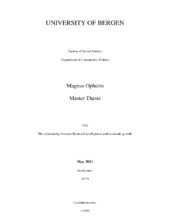| dc.contributor.author | Opheim, Magnus | eng |
| dc.date.accessioned | 2011-09-05T06:29:59Z | |
| dc.date.available | 2011-09-05T06:29:59Z | |
| dc.date.issued | 2011-06-01 | eng |
| dc.date.submitted | 2011-06-01 | eng |
| dc.identifier.uri | https://hdl.handle.net/1956/4932 | |
| dc.description.abstract | Developing countries in Asia and Africa have economically often been lagging behind the economies of the West. One reason can be found by looking at the executive capacities and the necessary financial structures. Global financial crisis has made the situation worse for many of the developing countries. What can be done to make developing countries in Asia and Africa stronger participants in the growing global economy? Will an improved financial sector reflected by an expansion of the insurance and banking industries and the stock market lead to economic growth? I will investigate this question by looking at the financial structures in selected developing countries in Asia and Africa. I have chosen panel data methods, GLS, GMM, Unit root tests and time series cointegration. My results show a causal relationship between financial development and economic growth. The economic structures in Asia enhance economic growth more than the African economies are able to. | en_US |
| dc.format.extent | 1167287 bytes | eng |
| dc.format.mimetype | application/pdf | eng |
| dc.language.iso | eng | eng |
| dc.publisher | The University of Bergen | eng |
| dc.title | The relationship between financial development and economic growth | eng |
| dc.type | Master thesis | en_US |
| dc.description.degree | Master i Sammenliknende politikk | |
| dc.description.localcode | SAMPOL350 | |
| dc.description.localcode | MASV-SAPO | |
| dc.subject.nus | 731114 | eng |
| dc.subject.nsi | VDP::Social science: 200::Political science and organizational theory: 240::Comparative politics: 241 | eng |
| fs.subjectcode | SAMPOL350 | |
